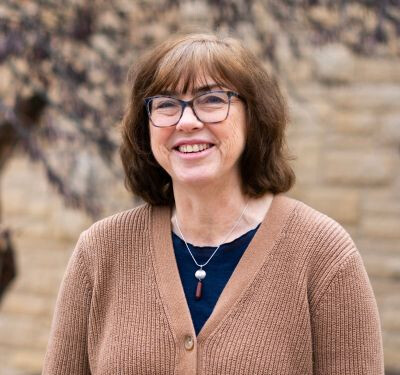Boosting Soil Health and Awareness Through Regenerative Agriculture Partnerships
Midwest Deputy Director Jean Brokish, Conservation Agronomist Torey Colburn, and Jenny Poling with ADM presenting about the re:generations program at the 2023 Farm Progress Show.How do you increase outreach and awareness? With partner organizations committed to the same goal. This seems obvious, but it is much easier said than done. After a few short weeks working at American Farmland Trust as a Midwest Region program manager, I have been amazed at the organization’s partnerships and networks. AFT fosters these established partnerships and is continually creating new networks of aligned organizations and farmers at the forefront of regenerative agriculture. Did you know drones and airplanes are being used to broadcast cover crop seed over the growing fields of corn, allowing the seed to drift down through the rows of tall plants and germinate after a rain? Mind Blown!
One of these partnerships is with Archer Daniels Midland to provide outreach and technical assistance for ADM’s re:generations program. Through this program, farmers are offered an incentive to increase cover crop adoption, whether a new system to their farm or they have been planting cover crops for years. It has been very successful so far, surpassing last year’s acreage numbers already, with enrollment closing later in November. In 2022, AFT and ADM launched the program with an initial goal of enrolling 75,000 cover crop acres. Nearly 300 farmers signed up, representing 112,414 cover crop acres. ADM and AFT enrolled an additional 278,696 acres in emissions scoring. Collectively, these two initiatives generated $2M in incentives for Illinois farmers.
The re:generations program offers flexible contracts to farmers willing to adopt cover crops and/or provide data to calculate carbon intensity scores. Reprovides those payments directly to farmers who enroll, and then the carbon assets generated are claimed by ADM. Farmers can enroll acres where practices have previously been used and then continue to re-enroll each subsequent season. ADM’s re:generations program offers a streamlined enrollment process, making it easy for farmers to participate in regenerative agriculture.
Another powerful partnership is with the Association of Illinois Soil and Water Conservation Districts to further the network of information available to farmers. Through a referral process, the re:generations program provides compensation back to participating districts for their efforts. Each participating district can then direct those funds locally to further their mission of preserving the soil and waterways of Illinois.
Torey Colburn, Midwest Region’s Conservation Agronomist with American Farmland Trust, shared, “Using cover crops coupled with sound agronomic management brings a lot of soil health and environmental benefits to the table. Cover crops can suppress weeds, improve soil structure, scavenge nutrients, increase soil water-holding capacity, and reduce soil erosion, just to name a few. The agronomic and environmental benefits are tangible and can have a tremendously positive impact on the health and productivity of our soils while protecting the quality of our air and water resources.”
Another partnership AFT is developing is with our Farmer Crop Reporters. We are so lucky to have farmers in our network motivated to teach their peers about the benefits of regenerative agriculture and land conservation. Although busy with the harvest, several of our Farmer Crop Reporters took the time to share a bit about their cover crop systems:
Colton Asche in Pecatonica: “Cover crops that were put on following wheat or flown on by mid-September are growing nicely after receiving some rain. We flew on some radishes and cereal rye in standing corn and soybeans with a drone in early September and broadcasted triticale after the early beans were harvested. Both have germinated and are growing with the moisture and heat we’ve been having.”
Paul Butler in Macon, IL: “We flew cover crops on in August-they are all up and look great. Buckwheat is up in corn stalks and flowering for the pollinators.”




